Ignition Coil: Essential Guide for 2010 Toyota Corolla Owners

The ignition coil is a crucial component in the ignition system of your 2010 Toyota Corolla. It transforms low battery voltage into the high voltage needed to ignite the air/fuel mixture in the engine's cylinders. Understanding the importance of this part, its replacement options, and maintenance can help ensure your vehicle runs smoothly.
Understanding Ignition Coils
An ignition coil consists of primary and secondary windings, a magnetic core, and an electrical mechanism. Its primary function is to generate a high-voltage current essential for engine ignition. A defective ignition coil can lead to misfires, reduced power, and poor fuel economy.
Signs of a Failing Ignition Coil
- Engine misfires
- Decreased fuel efficiency
- Rough idling
- Difficulty starting the engine
- Check Engine light activation
If you notice any of these symptoms, it may be time to inspect or replace your ignition coil.
Replacement Options for 2010 Toyota Corolla
When considering replacement options for your Corolla's ignition coil, you have several choices:
- Genuine Toyota Parts: The OEM ignition coil (part number 90919-02258) is designed specifically for your vehicle. It ensures optimal performance and reliability. The cost is typically around $90-$126 depending on the retailer.
- Aftermarket Brands: Options like Duralast and Beck Arnley are popular among Corolla owners. Duralast offers a reliable option priced around $63-$234 for multi-packs, while Beck Arnley is noted for quality as well.
- DIY Replacement Kits: Many retailers offer kits that include spark plugs and coils together, which can save time and money during maintenance.
| Brand | Part Number | Price |
|---|---|---|
| Genuine Toyota | 90919-02258 | $90 - $126 |
| Duralast | C1714 | $63 - $234 (multi-pack) |
| Beck Arnley | N/A | Varies |
How to Replace the Ignition Coil
Replacing the ignition coil in your 2010 Corolla can be a straightforward process if you follow these steps:
1. Gather Tools: You'll need a socket wrench (10mm), dielectric grease, and possibly new spark plugs.
2. Access the Ignition Coil: Open the hood and remove any plastic covers obstructing access to the engine.
3. Disconnect the Old Coil: Unplug the electrical connector from the old ignition coil and remove it by unscrewing it from its mounting.
4. Install New Coil: Place the new ignition coil in position, secure it with screws, and reconnect the electrical connector.
5. Test Your Vehicle: Start your engine to ensure everything is functioning correctly.
FAQs About Ignition Coils
- How often should I replace my ignition coil?
Typically, ignition coils should be inspected every 100,000 miles or when experiencing performance issues. - Can I replace just one ignition coil?
Yes, but it's often recommended to replace all coils at once for consistent performance. - What are signs of a bad ignition coil?
Common signs include engine misfires, rough idling, and decreased fuel efficiency.
Maintaining your vehicle's ignition system is essential for optimal performance. Regular inspections and timely replacements of components like the ignition coil can help prevent larger issues down the road.
Related Posts
-
7 Days To Die Car Battery: Essential Guide
26-01-2025 • 500 views -
Best Spark Plugs for Dodge Grand Caravan: A Comprehensive Guide
30-01-2025 • 215 views -
Ford Focus Dashboard Lights: Essential Guide
26-01-2025 • 152 views -
Blend Door Actuator Reset: Quick Guide for Drivers
30-01-2025 • 251 views -
727 Neutral Safety Switch Wiring Diagram: A Comprehensive Guide
30-01-2025 • 183 views
Latest Posts
-
Are O2 Sensors Covered Under Warranty
01-02-2025 • 378 views -
How To Turn Off Paddle Shifters Mercedes
01-02-2025 • 387 views -
2015 Chevy Traverse AC Recharge Port Location
01-02-2025 • 417 views -
Power Steering Fluid Leak On Passenger Side
01-02-2025 • 460 views -
Rear Brake Caliper Piston Won't Compress
01-02-2025 • 361 views
Popular Posts
-
EPC Light: Understanding Causes and Solutions
26-01-2025 • 1065 views -
Power Steering and ABS Light On: Causes and Solutions
27-01-2025 • 649 views -
V12 Engine Costs: What You Need to Know
26-01-2025 • 688 views -
Toyota Hiace: Fuel Efficiency Insights for 2025
26-01-2025 • 645 views -
Hino Warning Lights: Understanding Dashboard Alerts
26-01-2025 • 794 views
